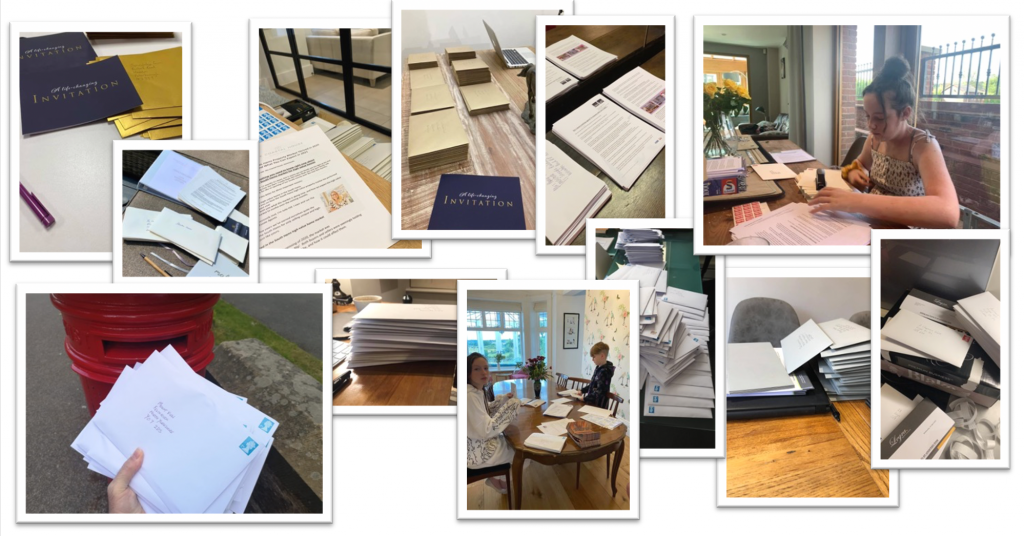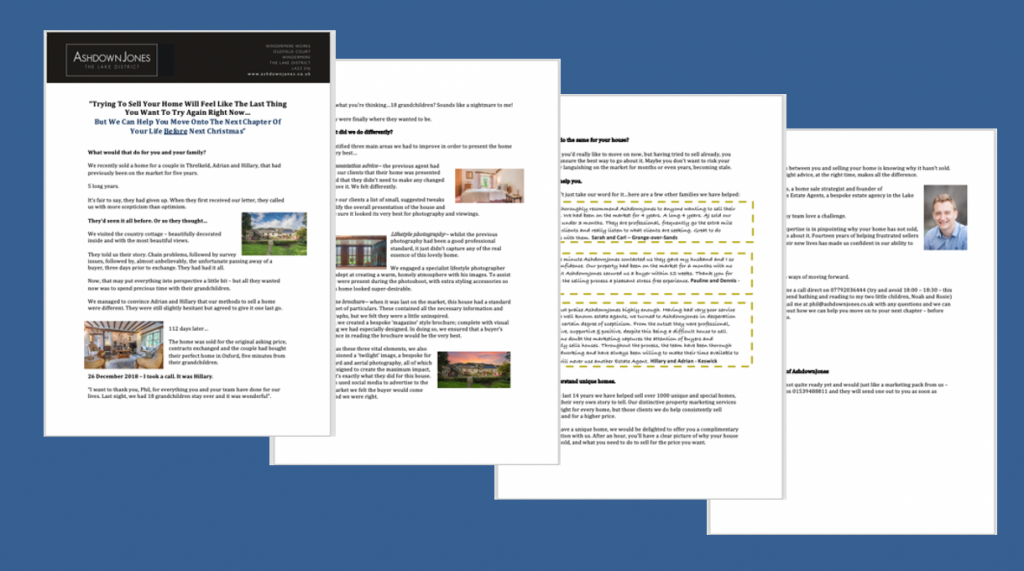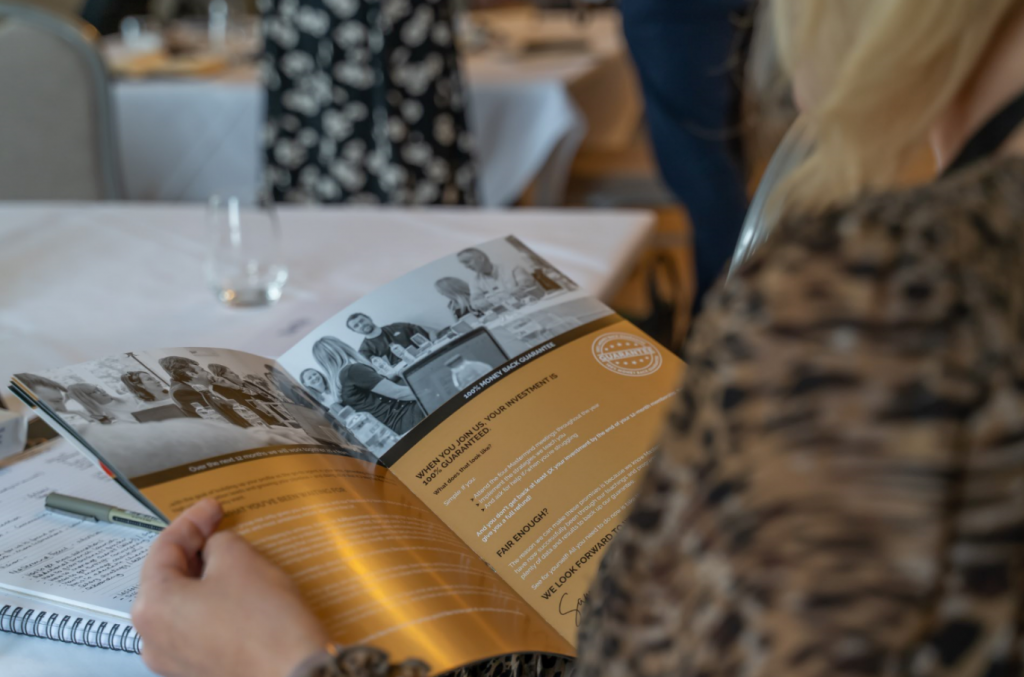If you could be sure you’d generate £73 in valuations from every single letter you sent out, how many letters would you send today?
‘Direct mail is too expensive, unwanted and outdated’, reads a recent comment on one of my Facebook posts. An interesting point of view…. Especially as we’ve generated £613,875 this year alone in potential fees with the 8,393 letters we sent.
That’s £73 per letter sent.
A LETTER IS NOT A LEAFLET
Do you have a recent canvassing leaflet nearby as you read this? Or can you remember it? What does it say? If it’s like any of the ones I’ve seen recently, it may say:
We have buyers waiting!
Thinking of moving?
We need your property to sell!
Is it working for you? And by working, let’s say, returning you more than half a percent response rate?
I know agents in London who continue to canvas in the tens of thousands each month to get a response rate of 0.1% and even less. That’s ONE response (just a call, NOT a val, or even an instruction!) in every TEN THOUSAND leaflets.
Can you afford to canvas on that basis?
Most canvassing is done on the basis that if it wins you one instruction, you get your money back, and more. But what if you don’t get any enquiries? I know agents who canvas up to 5,000 or even 10,000 leaflets a week, and get only a handful of enquiries each year.
And what if you’re trying to target landlords? It’s much more common to get a zero return, as most properties will be owner-occupied or let, and based on the balance of probability, landlords will be in the minority.
Imagine this:
You get home from work tonight to find this leaflet on your doormat:

This card fails on three counts:
Firstly, the answer to the question is yes or no: it forces the recipient down a cul-de-sac, and your card straight into the recycle bin.
Secondly, you’ve just got back from work, so chances are, the office is closed now. Even if you wanted to get in touch, you’d have to remember to save the card, take it to work the next day, and call when you had the chance. Too much like hard work, easier to pop it into the recycling instead.
Lastly, and most importantly, why should you call? What’s in it for you? Granted, we haven’t seen the reverse of the card; it could be chock-full of great reasons to make that call, but somehow I doubt it.
If I were advising this solicitor on their marketing campaigns, (an appealing prospect, now I come to think of it), I’d be telling them to use their canvassing to build relationships, not try to find the needle in a haystack that is someone thinking of using a divorce lawyer at that particular moment in time.
Think of it this way. The average UK marriage lasts 11 years, and I suspect that most unhappy spouses consider divorcing for at least a few months before taking the plunge to contact a solicitor. Let’s say that for a month, they are teetering towards making that call.
That means that the solicitor’s card has a 1/132, or 0.8% chance of arriving on that mat when that person needs it.
But what if the card arrived the month before, when they weren’t ready, or a month later, when they had already called another firm?
Pretty hit and miss, isn’t it?
Isn’t property canvassing the same?
Although the stats tell us that the average homeowner stays in their property for 23 years, we want the ones who move every 5-10 years. Let’s say you pick a street where the most likely first-time sellers live; perhaps it’s mainly flats. We know that roughly 2/3 of flats are tenanted, so only a third of your leaflets will be received by someone you want. Then you’re looking for that magic month in 60 (5 years) where they may be thinking of booking a valuation.
So your possible audience is 0.5%.
That’s why leaflets like this don’t work: (sorry, Dean Estate Agents)

CANVASSING IS AN ART AND A SCIENCE
The art part:
✅ Creating the right content for your direct mail piece
✅ Joining the conversation that’s already happening in the minds of the recipients
✅ Writing a compelling piece that has them reaching for the phone to book a valuation with you
The science part:
✅ Sending out the right number of direct mails per week
✅ Having a system to make sure it happens, no matter what
✅ Remembering that every letter sent out is worth £x to you (ours is £73 per letter sent)
Melding the art and the science parts of your direct mail campaign is an art in itself, if that’s not too meta. Get the science right, and you’ll make sure your direct mail gets printed professionally, addressed correctly and actually sent out. The art of making sure you’re saying the right words in the right order to capture a homeowners’ attention, and motivate them to pick up the phone, is more difficult to get right.
In fact, copywriting is such a skill, it’s incredibly rare to find a very good copywriter for sales copy like this. We know, because we’ve been searching for one for years. That’s why we (Phil and I), write the letters (both ‘on the market’ and ‘not on market’) ourselves.

THE TOP 5 MISTAKES ESTATE AGENTS MAKE WITH THEIR CANVASSING AND DIRECT MAIL:
1. Talking about themselves – no one wants to know what awards you’ve won, how long you’ve been established, or which governing body you’re registered with. Ultimately, we’re all only interested in ourselves. Use that fact to make your letter about them, not you.
2. Making the same old boring claims – ‘better than anyone else’, ‘friendly, professional service, ‘a passion for property’ – everyone’s heard these tired old statements a million times. Say something new, or don’t say anything.
3. Trying it once, then giving up – sending out 50 letters, once only, then claiming ‘direct mail doesn’t work’, is bonkers. Consistency is key. You wouldn’t expect to go to the gym once ever and have a six-pack, so apply some discipline and develop a direct mail habit.
4. Not sending out enough volume – you need to send at least 250 letters EVERY WEEK to get your phone ringing. Trust me when I say this. I’d love to tell you that you can get by with less, but if we can’t, you can’t either.
5. Sending out the wrong message to the wrong audience – our NOMs (‘not on market’ letters) are specifically written to attract a high-value vendor, and stimulate them to contact us. We wouldn’t get the same response by sending out these letters to say, terraced homes. They are not our audience. Know your audience, and write to them, specifically.
HOW TO GET A HIGHER RESPONSE FROM YOUR CANVASSING AND DIRECT MAIL
Remember what’s important:
1. Recipient
2. Message
3. Design
In that order. There is no point in having a terrific call to action (something they need to do) and be beautifully designed, if your landlord leaflet lands in a student house. However, a receptive recipient may respond (loving the alliteration) to a poorly designed postcard if the message strikes a chord for her personally.
Try: profiling all your previous respondents. Age, sex, location, type of house, life stage, etc. Going into detail with interests, occupation, family status and more, will help you laser-target those potential clients and reach out to them in your next canvassing campaign.
Thinking longer term
Forget property; think people. Focus on how you can get that one person to respond to something you send out, so you have their contact details. If you have selected the right streets for your campaign, you’ll know that 5% will probably move in the next year, and 15% are thinking about it. If you’re in touch with them when they decide to take the plunge, you’ll at least be in with a chance of an appointment.
Try: something completely different. Make the call to action really easy, like a contest, or a survey: something that needs a response.
Integrative campaigns
Canvassing shouldn’t be a standalone activity. It needs support from all of your other marketing campaigns. Social media, newspaper advertising and your email campaign, should carry the same theme and message at that time, for the chance at the best return.
Try: ask your graphic designer to create a multi-channel campaign for you. Pick three media and ask them to design the different formats you need.

STOP TALKING ABOUT CANVASSING – AND START TALKING ABOUT DIRECT MAIL
You’ve probably heard about our legendary direct mail letters we write for our AJ Mastermind members. The results we and our members have had are phenomenal, especially recently, when stock is at an all-time low – these sales letters have given us all a much-needed stock boost.
But a big question we get asked all the time is…
“What letters should we send to which properties?”
After all, there’s no point in us giving you a world-class direct mail letter if you don’t know which homes to send it to.

Here are our top 3 markets to send our direct mail letters to, and the types of letter they each need:
Market 1: Not on the market
If you’re going to send a ‘not on market’ letter, its content needs to address the fact that their home is not for sale. Of course, you’re not going to start your letter with ‘the reason we’re sending you this letter is because your home isn’t on the market’, but the content of the letter needs to be interesting and useful enough to be relevant to that occupier, whether or not they are intending to sell.
That’s why we love data and statistics. Not only do they make the letter relevant to any owner-occupier, they give you the gift of credibility, unlike opinion.
Top tip – make your letter’s content laser-focused on that street, area or type of house. For example, we target only high-value homes in certain areas of the Lake District. This means we can use the language that we know will best appeal to those owners. This gets the attention of the owner, as we’re speaking directly to them, and we’re also speaking to their ego and status.
Market 2: Withdrawn from the market
A not-on-the-market letters is of course relevant for a home that was once on the market, but isn’t any longer, BUT, a specially-written ‘withdrawn’ letter is much stronger and will usually have a better response.
The market for withdrawn homes is one that very few agents target. At least, not successfully. Having targeted withdrawn homes since we first opened AshdownJones in 2017, we know what a profitable market it can be.
Even those homes that were last on the market five years ago, or longer, can be ready to move with the right approach.
Maybe they spent a year or more on the market but something didn’t go to plan.
Perhaps they found a buyer that later pulled out of the sale, or maybe the relationship they had with their estate agent was damaged for some reason. Or they may have simply had a change in their personal circumstances, and decided to put their house move on hold.
Whatever the reason for their decision to stay put, two things are certain: firstly, they will move house at some point, and secondly, it’s unlikely they will go back to their original agent.
Both of these facts present an opportunity for you.
It’s also a market that isn’t often spoken to directly by agents. They may send a ‘not on market’ letter, but this isn’t anywhere near as relevant or direct as a letter that acknowledges the fact they were once intending to move house. Sending a skilfully-written letter to these specific homes will significantly differentiate you above those agents who blanket mail every property.
The market for withdrawn homes is a ‘warm’ market. Warmer than the homes that are not currently on the market at all, but cooler than the homes on the market.
Top tip – there is currently a significant delay in the registering of sales. This means you can’t assume that because there is no sale registered, the property is not actually sold. This means you’ll have to go back quite some time before you can rely on the data you find. In a strong market like this one, this is even more important. During the last couple of years, many homeowners who had originally planned to sell, put their plans on hold until the market was more certain, which it now is.
Market 3: On the market homes
We send a specially crafted letter each month to those homes in our area which would fit our requirement as a unique home. We’re very selective with the homes we target and list, so tend only to market those homes in the top 20% or so, in terms of value. In our area, this is around £500,000 and upwards, although we do market to some special homes that are less.
Your biggest challenge when targeting on-the-market homes is to write a letter that will stand out above all the other letters your competitors will send.
How do you differentiate on the doormat? How do you make the message different?
How do you create rapport with the reader from the headline onwards, so they read to the end?
These challenges and more are ones we all have to overcome. We teach our AJ Mastermind members the exact method of sending – envelope, address, stamp, etc – to make sure their letter actually gets opened. In following this formula, and sending out the specially-written letters we give them every month, some members have had responses of 10%+ from on-the-market homes, and 5% from not-on-market properties – an astonishing success rate, particularly as they often find they are the only agent invited out.
Top tip – don’t use triggers to decide when to send your letters. Whilst other agents will be sending their letters when the property first comes to market, then after 4 weeks, 8 weeks and price reductions, to stand out, you need to do the opposite. We don’t use triggers at all. We send our letters according to our schedule, not theirs.
After all, we have no way of knowing if the homeowner is dissatisfied with their agent from day one, or happy with their lack of a sale after a year or more. Let your letter find that out, without relying on a trigger.

WHAT EXACTLY IS DIRECT MAIL?
Is it canvassing? Is it leaflets? Is it postcards?
Direct mail is a letter addressed to a person, or an address, or both. Unlike leaflets, which are sent out indiscriminately door to door, direct mail is highly targeted and sent to a specific address.
I know, I know – a leafletting campaign is so much easier to create and deliver. You simply get them designed and printed, then push them through every letterbox in your area. It’s cheap and cheerful – but it doesn’t actually work. In fact, because leaflet response rates are so dismal, it will prove more expensive in the long run to lead-gen in this way.
If you can be selective in your mailings, if you target just a small group of home-owners with a carefully crafted series of letters, it’s far more effective for your wallet, and for the environment. It’s also better for the recipients of your letters, as they’ll feel they’ve been targeted specifically and that makes your piece of direct mail worth so much more to them than a random leaflet.
A stamped, handwritten envelope is pretty certain to be opened, and anyone who does take the time to read two or even three pages of a well written letter is far more likely to take an action at the end of it. If you invest several minutes absorbing and engaging with a brand’s content, you’re much more likely to act in accordance with that time investment.
What should your direct mail actually say?
Between me and Phil, we’ve read, listened to and studied over 1,000 books, podcasts and audiobooks on the subject of direct mail. We’ve learned the hard way how to get someone to respond to a letter sent to them. And now, we really know our stuff. That’s why, even in our first year of running AshdownJones, around 70% of all our fees were attributable to our direct mail letters.
At times, we were getting a whopping 10% response rate, and we were able to build on that early success to really make a name for ourselves in an area that had never heard of Ashdown, never mind Jones.
Here are the main components you need to get right in your direct mail piece:
- Your headline – needs to be compelling and grab their attention from the start
- Your first paragraph – they have to feel that reading the letter is in their interest, not yours
- The length – longer copy outsells shorter copy, every time. Trust me on this. Our letters are usually 6 pages long.
- The call to action – make it easy for them to say yes. A phone call might be too high an ask, so offer them an easier way to get in touch.
- The envelope – hand-written and with a stamp, not a frank. This is super important! No window envelopes either.
If you do all the above, you’ll find your phone starts ringing, and your email starts pinging – and it all begins with that letter, so get writing.
OR…. ASK US ABOUT AJ MASTERMIND
If you’ve ever struggled to write a direct mail piece, or sales letter, we understand. It’s hard!! That’s why for some agents, it’s more efficient and effective option to use ours. We only work with one agent in each postcode district. To check if we already supply one of your competitors, send me an email and I’ll let you know if your area is still free.

As you can see here from our methods and results, all three markets can be very lucrative to target, but you have to have the right letter to send. This is where we come in. As an AJ Mastermind member, you get a not-on-market (NOM) letter once a quarter, and an on-the-market letter every single month. We also give you our hugely successful withdrawn letter.
Not only do we give you the tools to attract the very best homes in your area, even if you are a brand-new agent, we also give you the exact methods you need to find and choose the right homes, via our AJ Academy. This includes such training as our now infamous ‘LEGEND’ conversion training, so you convert these high-value leads at the best fees.
BUT – we only work with just ONE agent per area, and 43 areas have already been taken. To find out if your area is still free, just click HERE and tell me where you are. I’ll let you know straight away if your area is available, and we can have a chat to see if the AJ Mastermind is a good fit for your business goals.

What to do next: book on our next FREE ‘Behind the Scenes at AJ Day!
What to read next: The Fabulous Follow-Up – three steps to winning the instructions you love
What to listen to next: The Ignite Podcast episode 75: The Business that can Spend the Most to Acquire a Customer Wins



I will like to you to help in me canvassing/ letter for my estate agent/ direct mail to landlord.
Thanks